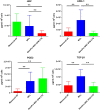Umbilical cord-derived mesenchymal stem cells cultured in the MCL medium for aplastic anemia therapy
- PMID: 37649079
- PMCID: PMC10470151
- DOI: 10.1186/s13287-023-03417-1
Umbilical cord-derived mesenchymal stem cells cultured in the MCL medium for aplastic anemia therapy
Abstract
Background: Mesenchymal stem cells (MSCs) are a class of adult stem cells with self-renewal and multidirectional differentiation potential that may be a treatment for aplastic anemia (AA).
Method: Umbilical cord-derived MSCs were cultured in three media (Mesencult-XF, MCL, and StemPro MSC SFM CTS). HGF, PGE2, ANG-1, TGF-β1, IFN-γ, and TNF-α were detected using ELISA. The AA mouse model was built via post-irradiation lymphocyte infusion. After different treatments, routine blood, VEGF, and Tregs were detected every week. On day 28, all mice were killed, and their femurs were stained with HE.
Results: Umbilical cord-derived MSCs cultured in the three media all conformed to the general characteristics of MSCs. HGF secreted by MSCs in the Mesencult-XF, and MCL was greater than that in the StemPro MSC SFM CTS; ANG-1 and TGF-β1 in the MCL were more than that in Mesencult-XF and StemPro MSC SFM CTS; PGE2 in the MCL and StemPro MSC SFM CTS was more than that in the Mesencult-XF. MSCs in the MCL and StemPro MSC SFM CTS inhibited IFN-γ and TNF-α more than those in the Mesencult-XF. The peripheral blood cell in the AA groups was at a low level while that in the MSC group recovered rapidly. The Treg ratio and VEGF level in the MSC group were higher than those in the AA group. The bone marrow (BM) recovered significantly after MSC infusion.
Conclusion: MSCs in the MCL were advantageous in supporting hematopoiesis and modulating immunity and had the potential for effective treatment of AA.
Keywords: Aplastic anemia; Mesenchymal stem cell; Umbilical cord; Wharton's jelly.
© 2023. BioMed Central Ltd., part of Springer Nature.
Conflict of interest statement
The authors declare that there is no competing interests.
Figures







Similar articles
-
Isolation method and xeno-free culture conditions influence multipotent differentiation capacity of human Wharton's jelly-derived mesenchymal stem cells.Stem Cell Res Ther. 2013 Jul 11;4(4):81. doi: 10.1186/scrt232. Stem Cell Res Ther. 2013. PMID: 23845279 Free PMC article.
-
Combination of umbilical cord mesenchymal stem cells and standard immunosuppressive regimen for pediatric patients with severe aplastic anemia.BMC Pediatr. 2021 Feb 27;21(1):102. doi: 10.1186/s12887-021-02562-x. BMC Pediatr. 2021. PMID: 33639900 Free PMC article. Clinical Trial.
-
Differential expression of cell cycle and WNT pathway-related genes accounts for differences in the growth and differentiation potential of Wharton's jelly and bone marrow-derived mesenchymal stem cells.Stem Cell Res Ther. 2017 Apr 26;8(1):102. doi: 10.1186/s13287-017-0555-9. Stem Cell Res Ther. 2017. PMID: 28446235 Free PMC article.
-
[Defectiveness of bone marrow mesenchymal stem cells in acquired aplastic anemia].Zhongguo Dang Dai Er Ke Za Zhi. 2015 Jan;17(1):100-6. Zhongguo Dang Dai Er Ke Za Zhi. 2015. PMID: 25616306 Review. Chinese.
-
Mesenchymal Stem Cells in Acquired Aplastic Anemia: The Spectrum from Basic to Clinical Utility.Int J Mol Sci. 2023 Feb 24;24(5):4464. doi: 10.3390/ijms24054464. Int J Mol Sci. 2023. PMID: 36901900 Free PMC article. Review.
Cited by
-
Mesenchymal stromal/stem cells from perinatal sources: biological facts, molecular biomarkers, and therapeutic promises.Stem Cell Res Ther. 2025 Mar 7;16(1):127. doi: 10.1186/s13287-025-04254-0. Stem Cell Res Ther. 2025. PMID: 40055783 Free PMC article. Review.
References
-
- Bernardo ME, Fibbe WE. Mesenchymal stromal cells: sensors and switchers of inflammation. Cell Stem Cell. 2013;13(4):392–402. - PubMed
-
- Nauta AJ, Fibbe WE. Immunomodulatory properties of mesenchymal stromal cells. Blood. 2007;110(10):3499–3506. - PubMed
-
- François M, Romieu-Mourez R, Li M, Galipeau J. Human MSC suppression correlates with cytokine induction of indoleamine 2,3-dioxygenase and bystander M2 macrophage differentiation. Mol Ther. 2012;20(1):187–195. - PubMed
Publication types
MeSH terms
Substances
LinkOut - more resources
Full Text Sources
Medical
Research Materials
Miscellaneous

